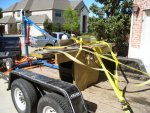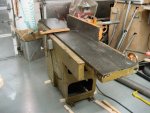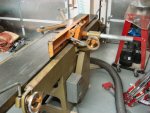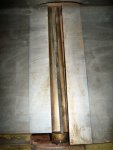Mike Forsman
Member
- Messages
- 89
- Location
- North Central Texas - DFW
I had been wanting to upgrade my jointer from the 6" machine I currently have. Was thinking about on the 12" combo units. But, I ran across this at a really good deal. I brought this home on Friday. It is an older 12" jointer. Quite a step up from the 6" jointer I had previously.
First picture is of the jointer loaded on the trailer after the trip home.

After getting it off the trailer prior to getting it into the shop.

Waiting to be connected up to power.

After trying it out.

View from the back.

I need to do a jointer tuneup and it needs to have the blades sharpened. At some point, I will re-paint it and do a restore.
One of the things I don't have any experience with is how to set the knifes when they look like this.


As you will notice in the pictures, the blades don't go straight across the cutter head. They are at a slight angle. Any suggestions about how to get it the same height across the width of the blade and from blade to blade?
First picture is of the jointer loaded on the trailer after the trip home.

After getting it off the trailer prior to getting it into the shop.

Waiting to be connected up to power.

After trying it out.

View from the back.

I need to do a jointer tuneup and it needs to have the blades sharpened. At some point, I will re-paint it and do a restore.
One of the things I don't have any experience with is how to set the knifes when they look like this.


As you will notice in the pictures, the blades don't go straight across the cutter head. They are at a slight angle. Any suggestions about how to get it the same height across the width of the blade and from blade to blade?

 I'm sure there will be someone respond with the CORRECT way to set the blades. I've never set up one of those, but If I had to do it AND couldn't get a knowledgeable response, I would attempt it by doing the following:
I'm sure there will be someone respond with the CORRECT way to set the blades. I've never set up one of those, but If I had to do it AND couldn't get a knowledgeable response, I would attempt it by doing the following: